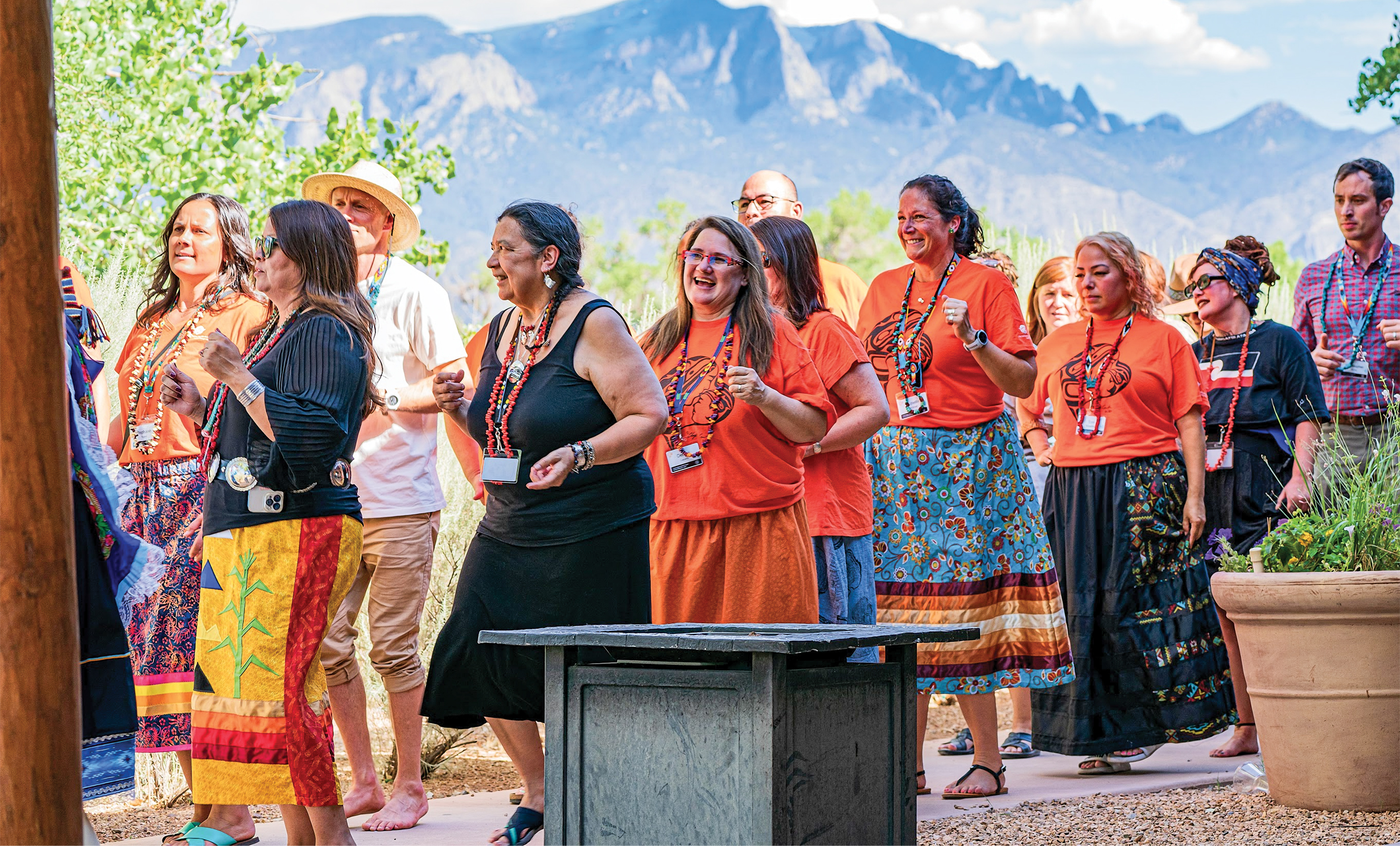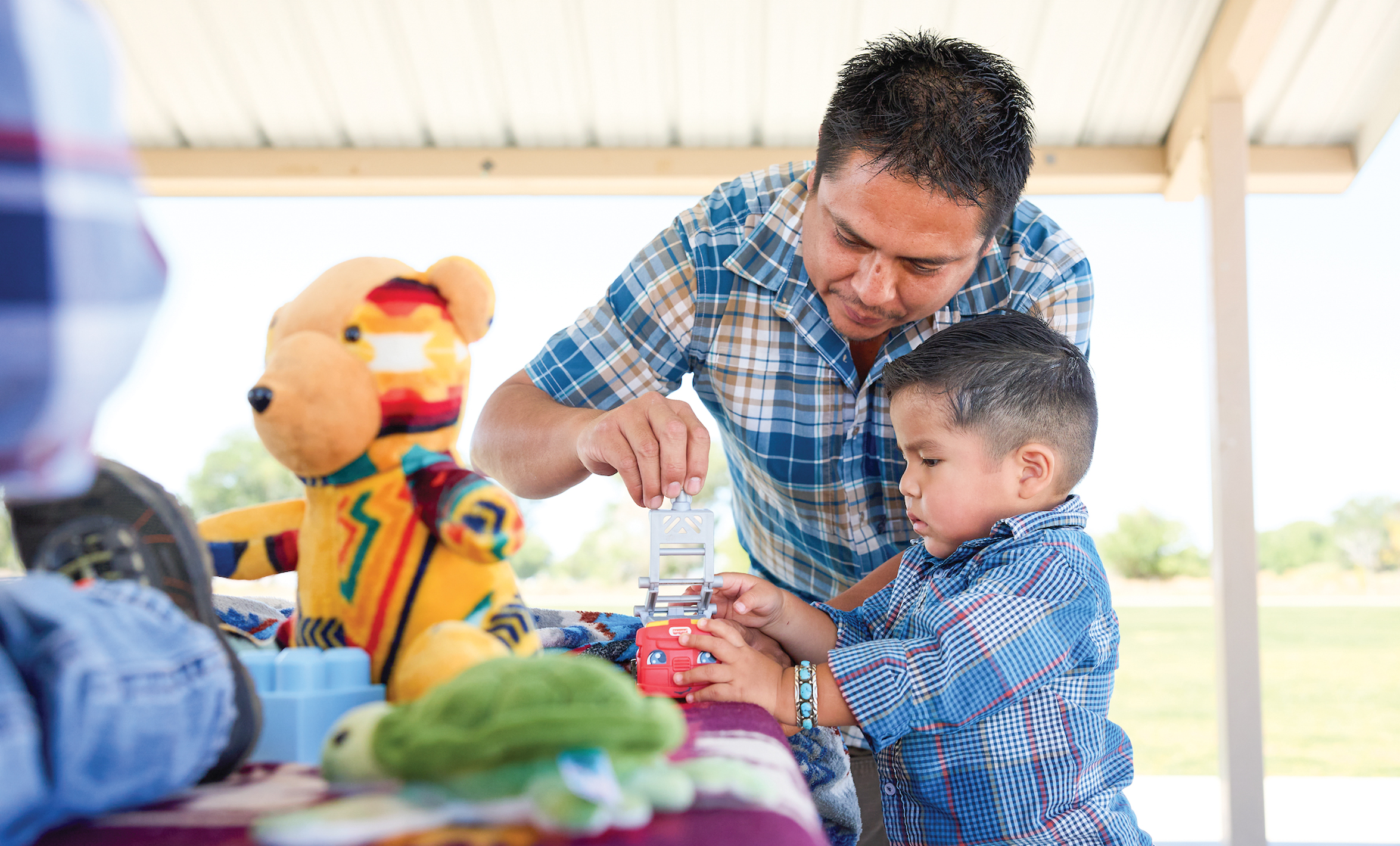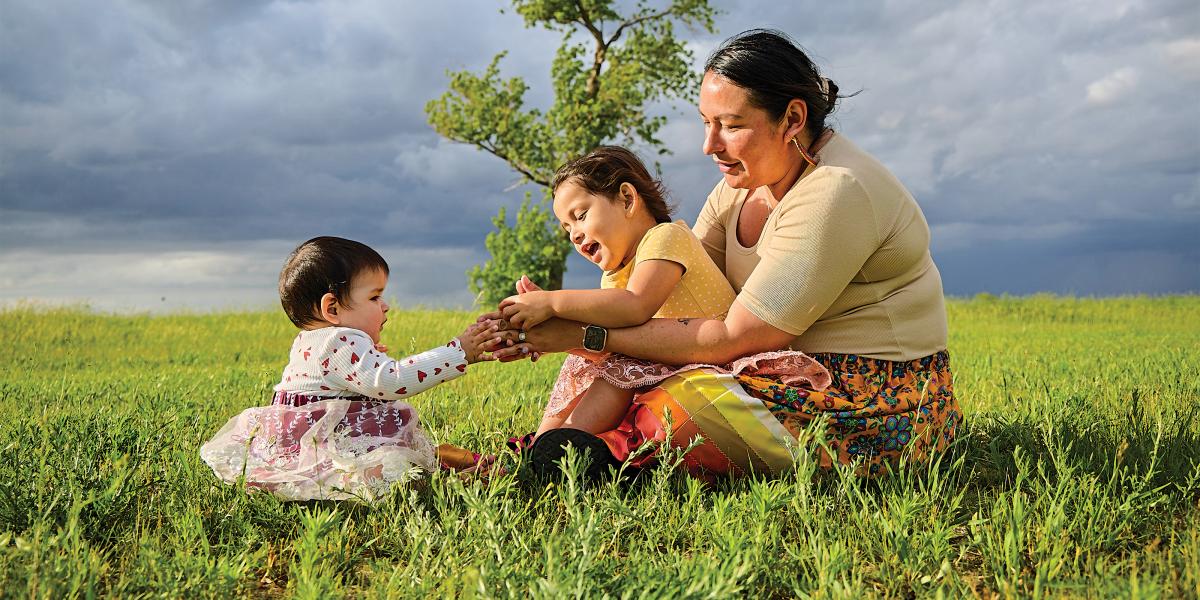Reclaiming Health in Indigenous Communities
Indigenous peoples are overcoming centuries of colonization by reclaiming the health of children and families.
Standing under the desert sun, Indigenous peoples from four different countries gather among ancient cottonwood trees. A young Māori singer, Soraya Kamau, leads the opening ceremonies with a soaring call-and-response chant. Nearby, the Rio Grande River and craggy peaks of the Sandia mountains bear witness.
A Māori ritual on the Pueblo of Santa Ana.
That call, the karanga, is an essential piece of the Māori pōwhiri, a welcome ceremony that is standard protocol when arriving as guests on someone else’s land.
“It’s a calling to all our ancestors and calling to the lands to bring us on,” explains Paula King, PhD, a Māori public health physician and clinical research fellow at the University of Otago in Wellington, New Zealand.
It was among a number of welcome rituals from Indigenous partners—all awardees in the LEGO Foundation’s Build A World of Play Challenge—who met that July evening for the first time in person, bringing together Indigenous peoples from First Nations, Canada; Aboriginal peoples from Australia; the Māori peoples from Aotearoa (New Zealand); and Indigenous hosts from the southwestern U.S. and Johns Hopkins Center for Indigenous Health. From thousands of miles apart, they came with a shared mission: to reclaim health and well-being for their youngest children and their families.
On a swath of land known as Tamaya, or “a quiet, peaceful place,” they tasted the bread of the Santa Ana Pueblo people—the food blessed by an elder from Squamish Nation in Canada. They were gifted corn necklaces made by the Santa Ana people; pressed their foreheads together in a tender Māori greeting; received beaded orange pins honoring First Nations children who never returned from residential schools. Elders from Australia brought with them a goanna lizard sculpture, a gift symbolizing connection to land. Finally, they linked arms in a joyful Zuni friendship dance.
In the spirit of kinship between guests and hosts, Melissa Sanchez of the Santa Ana Pueblo people guided the procession toward her husband, the former Pueblo War Chief Emmett Garcia, who sang in Keresan.
“You are welcome here,” Garcia told them all.
A serenade of cicadas chimed in on cue. It was an important endorsement from the natural world, Crystal Austin, of the Center for Indigenous Health and a member of the Navajo tribe, explained later. According to the Navajo creation stories, the cicada, an ancestor, sought out a new home for the Diné. “Their songs were saying on that day, ‘You are in the right place.’”
They came together to share, drawing on the power of their cultures, their common histories of European colonization that tried to erase their traditions and health, and their commitment to healing their communities by recentering their shared Indigenous views of health. Their concepts of health stretch far beyond the individual body—beyond the dominant Western biomedical concept of health as the “absence of disease”—and is instead defined by a balance of spirituality, traditional medicine, the health of Mother Earth, and the interconnectedness of all things. There’s a phrase for this in Lakota: Mitákuye Oyás’iŋ. We are all connected.
These Indigenous community strengths—rather than deficits and health inequities—are the centerpiece of the partners’ efforts to break the cycles of historical trauma and improve health outcomes in their communities. All the partners—who represent the University of Otago in New Zealand, the Batchelor Institute in Australia, the First Nations Health Authority in Canada, and the Johns Hopkins Center for Indigenous Health—have been hard at work promoting these values through their work back home. But to share the experience with understanding colleagues across the globe is nothing short of profound, says Kelly Hearn, of Te Hou Ora Whānau Services, a Māori parenting program facilitator in Dunedin, New Zealand. She agreed with the cicadas. They were all in the right place.
“When my feet hit the ground, I felt this vibration. … It was wairua [the spirit],” she says. “I felt it from generations back. There were thousands of people there.”
Now, the work could begin.

In the Māori language, the word whenua means two things: birth and land. The two are inextricably linked.
Traditionally, when a Māori baby is born, their placenta and umbilical cord are buried on ancestral lands in a basket woven from leaves of harakeke, or flax, rooting them among their fellow descendants of the Earth Mother. The plant—a striking red bloom surrounded and protected by layers of overlapping leaves—encapsulates how Māori engage their children with the world, says King.
“If you cut the core of the plant or its leaves, the plant won’t be sustained and will die,” she says. “So one of our models for health is about the baby being the center of the plant, surrounded by their parents and caregivers, and the fano—the extended family—are the rest of the leaves.”
Thousands of miles away on Navajo Nation, umbilical cords are buried in the same spirit. And Aboriginal Australians may bury their children’s umbilical cords near an ancient boab tree, which are often carved with Indigenous artworks. For these communities, rituals that anchor children to their generations past and future, and to the spiritual world, are essential for a healthy start in life. Nonmedical practices like prayer, songs, ceremony, intergenerational connection, and storytelling are not adjacent to health—they are integral to it.
Studies back this up. A landmark 1998 paper published in Transcultural Psychiatry quantified the link between connection to culture and reduced suicide risk. It revealed that First Nations communities in British Columbia with low rates or absence of suicide also had deeper cultural continuity through self-government, land ownership, control of education, health and social programs, intact families, and traditions that had been passed down through generations.
Decades later, Indigenous scholars are still working to promote this knowledge in mainstream spheres of power. In April, authors who included leaders from the Center for Indigenous Health released a report at the UN Permanent Forum on Indigenous Issues that explicitly defines the barriers to Indigenous well-being—institutionalized racism, ongoing trauma, and the degradation of traditions—and names self-determination, access to traditional medicine, land, and sacred places among the essential protectors of Indigenous health.
“We’ve had hundreds of years of trying to use the colonizers’ perspective on promoting health and treating disease. And clearly it’s not working,” says Donald Warne, MD, MPH, a member of the Oglala Lakota tribe from Pine Ridge, South Dakota, a physician, and co-director of the Center for Indigenous Health. “We have enough empirical evidence to prove that.”
Along the way, “we’ve lost our traditional ways for raising families and communities and we’ve adopted the colonizers’ systems, which are not as healthy,” says Warne.

Centuries of colonization eroded Indigenous cultural traditions with devastating impacts on the health of Indigenous people. The colonizers broke apart communities, violently evicted Indigenous people from their homelands, removed children from their families, engaged in religious indoctrination, deliberately dismantling Indigenous traditions and well-being practices, and banned traditional languages.
One way they did this was by forcibly placing Indigenous children in residential schools run by colonizers. From the 1800s until the 1990s, U.S., Canadian, and Australian residential schools aimed to assimilate Native children by eliminating Indigenous language and culture. Many children ended up in unmarked graves that are still being uncovered. “The goal was to kill the Indian, and they did an effective job,” says Elder Syexwaliya Ann Whonnock, Squamish Nation, who traveled from Vancouver as an adviser to the First Nations Health Authority.
Indigenous Australians and Māori also endured violent cultural suppression. Racist, colonialist polices left deep scars on the health of Indigenous peoples, driven by displacement from land, loss of socioeconomic opportunity, and limited access to health care.
Colonization’s health impacts have been catastrophic. Globally, life expectancy among Indigenous people is up to 20 years less than among non-Indigenous people. They experience significantly higher rates of diabetes and other noncommunicable diseases, higher levels of maternal and infant mortality, and a heavy toll of depression, suicide, and substance abuse that have been linked to historical trauma and the fragmentation of Indigenous communities.
King adds that Indigenous peoples have more in common than the barriers to well-being put up through a colonized, racist society. “We also share a reverence for life, for our environment,” she says. “We very much want to move back to that.”
The partners are propelled by the belief that just as health inequities and loss of culture go hand in hand, so do solutions to both—from mental health support for Māori youth to First Nations Head Start programs that prioritize First Nations languages. These efforts are not just for the benefit of those living today, says Michelle DeGroot, a Family Spirit partner with the First Nations Health Authority.
“We’re thinking seven generations from now ... about our children’s children’s children’s children’s children,” she says.

“Cultural connection is at the heart of this work,” Crystal Austin says in a hotel conference room packed with Indigenous partners who would soon launch the Family Spirit program in their communities.
The in-home parent training and support program was established in 1995 by what is now the Center for Indigenous Health, in partnership with the Navajo, White Mountain Apache, and San Carlos Apache tribal communities. It has been replicated nationally and now serves over 100 tribal communities across 26 states, in addition to a handful of non-Indigenous communities.
Delivered by Indigenous paraprofessionals trained to teach the Family Spirit curriculum, the program supports caregivers during pregnancy and early childhood. Families meet with the same home visitor during pregnancy and for three years postpartum. “Maybe we’re meeting them in the parking lot at their job, at home, or by phone,” says Austin, a senior adviser to Family Spirit leading who got her own start with the program as a home visitor.
Together, they can complete up to 63 lessons covering prenatal care, infant care, breastfeeding, developmental milestones, home safety checks, and maternal mental health, as well as cultural values.
Willena Begay, 36, joined the Family Spirit program when her first child, now 16, was an infant, and is now in the program with her seventh, now 6 months old. She lives off an unpaved road in a remote part of the Navajo Nation known as Cross Canyon, Arizona. “It’s not on the map … yet,” she says. Near her mother and sisters, Begay lives in a hoghaan—a traditional Navajo home. “There’s no electric, no running water. We haul water from a windmill and have a propane stove and heat from a wood stove,” she explained over a patchy phone line.
“It’s one of our ancestors’ homes,” she says. “I’ve always wanted to raise my kids in a hoghaan because I was raised in one with my mom and my sisters.” Her daughter’s umbilical cord is buried at her mother’s home nearby—to which she attributes the almost magnetic draw her daughter has to her grandmother’s home.
None of this has to be explained to Begay’s Family Spirit home visitor, Tanya Jones, who has worked with CIH for nearly 20 years. In their weekly meeting, Jones, who is also Navajo, may show her how to wipe down her teething baby’s gums or go over a lesson on controlling emotions in heated situations. There are developmental checks for language, growth, and other milestones. The use of cradleboards—a traditional wooden baby carrier—is incorporated into the sleep safety curriculum; lessons on first foods include traditional foods like blue corn mush and mutton broth.
“We have this Navajo clanship. She’s one of my relatives pretty much. We really bond because of that,” Begay says, adding that that’s made it easy to stick with the program.
The only federally endorsed home visiting program for Indigenous communities, Family Spirit has generated strong evidence of the effectiveness of Indigenous paraprofessionals as home visitors to impact behavioral and mental health inequities. The program’s benefits have been backed up through three randomized controlled trials. The findings show that 91% of participants stuck with the program for a full year postpartum, and 83% until their babies’ third birthday. The program increased maternal knowledge; reduced parent stress; improved home safety attitudes; decreased maternal depression, maternal substance use; and behavior problems; and promoted children’s social, emotional, and behavioral development in early life, which is predictive of lower risk of substance use and behavioral health problems throughout life for these children.

Now, with an influx of $27.8 million in funding from the LEGO Foundation’s Build A World of Play Challenge, a five-year initiative will open 20 new Family Spirit program sites in the U.S., Canada, Australia, and New Zealand, with each shaping the program according to their local needs, visions, and cultural protocols. It will also add a new element to the program: play spaces that foster engagement between generations and celebrate traditional community parenting, nature-based recreation, and cultural teachings.
Since December 2022, this expanded cadre of Family Spirit partners has been sharing ideas from afar on how to expand and adapt the program to their own communities and learning from one another as they go. The LEGO grant provides funding and a support network to implement the core curriculum and adapt its cultural elements around work they’re already doing to preserve cultural practices as a means to protect health.
“The Family Spirit curriculum is now a giant feast of proven lessons. They’re choosing sections that meet their immediate needs,” says Allison Barlow, PhD, MPH ’97, MA, executive director of the Center for Indigenous Health. The Māori group plans to focus on “My Family and Me,” a section on family involvement and developmentally and culturally appropriate play. The partners in Australia want to focus on modules that will help reunite families with children placed in protective services by helping them meet the criteria for court-ordered education. And for many of the partners, using the program to preserve native languages is a top priority—and a well of opportunity to rebuild intergenerational connection.
“Colonization was a cultural bomb,” said Kathryn Gilbey, PhD, an Alyawarre scholar and executive dean of the Batchelor Institute of Indigenous Tertiary Education, said as she stood at the podium, addressing her colleagues. Among its greatest casualties are the languages that hold and pass down Indigenous ways of being. There’s a long way to go to preserve those languages, “But when we’re on the right path, we’re sure-footed,” says Gilbey.
Gilbey showed the gathering a playful video of a charismatic elder as she runs among children in her village, and joyfully teaches them “Head, Shoulders, Knees, and Toes” in Pertame, a critically endangered language which had just 20 fluent speakers in 2018.
To whoops and cheers, Gilbey announced the site of their project’s first intergenerational play space, a cornerstone of their plans to expand an immersive language nest program where “English stays outside,” says Shania Armstrong, a 19-year-old Pertame speaker from Mparntwe (Alice Springs), Australia. As part of a master-and-apprentice program, she sits down with her elders for 20 hours per week to learn her native language, and then shares what she’s learned with young children through educational games and songs. “This is something in my heart that I’m really passionate about. I need to save my language—it’s my identity,” she says.
Denise Lacerte, of Nadleh Whut’en First Nations in Canada, shares that determination for her own people. She holds in her palm a brooch in the shape of a tiny t-shirt strung together from bright orange beads—the color of solidarity for the victims of residential schools. Her own grandmother survived residential school, but, after being punished for speaking her language, never passed the language down to her children or grandchildren. “The ripple effects of residential schools are still being felt” in loss of culture for First Nations people, says Lacerte, a senior specialist working on programs for children. “But we’re turning it around. Culture and language are at the center of the programs we offer. Children get to be proud of who they are and their identity,” she says.
Paula King counts herself lucky to have grown up with that sense of pride and close ties to the lessons of her elders. One in particular, who recently passed away, left behind a perspective that she carries with her in her work: “He always told us that colonization is just a blip,” she says. “Our values have kept us alive for thousands of years, and we’ll keep going.”
